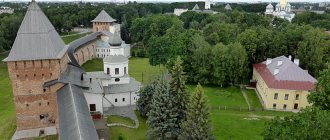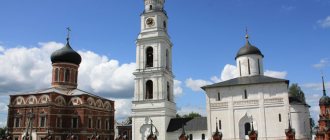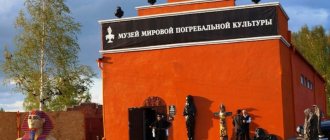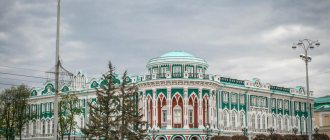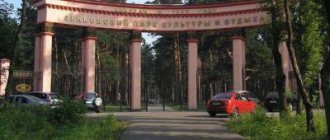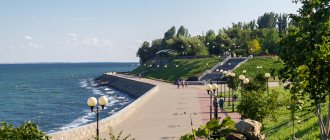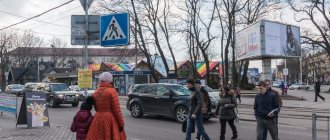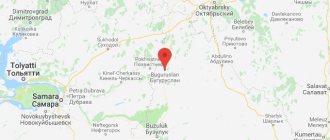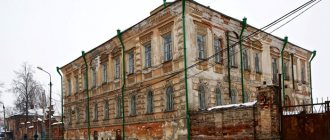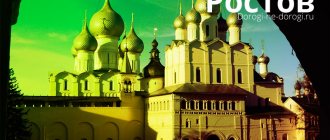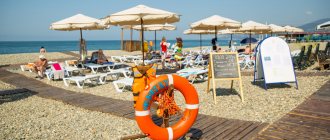Kaliningrad is called a city with a European spirit and Russian soul. The city is located in the westernmost part of Russia and is separated from the rest of the country by the territory of Poland, Lithuania and Belarus. Before the Great Victory in 1945, it belonged to Prussia and was called Königsberg. Kaliningrad attracts tourists with its ancient German architecture, green parks, modern museums and funny sculptures. We have compiled a list of 15 must-see attractions in the city.
Fishing village
The complex of buildings in the old German style, built in 2005 on the embankment of the Pregolya River, is called “little Europe”. The best postcard views in Kaliningrad open here. There are several restaurants overlooking the river, three hotels, souvenir shops and a lighthouse with an observation deck from where you can take panoramic photos. The tents sell mulled wine and pastries, and sell amber souvenirs. River boats depart regularly from the Pregolya pier - ideal for a romantic walk. Opposite the Fishing Village is Kant Island, where the Kaliningrad Cathedral is located.
Fishing village, Kaliningrad
Address:
st. Oktyabrskaya, 2-8, Kaliningrad.
A few facts about Kaliningrad
- The founding date of the city of Königsberg is 1255.
- The population of the city at the beginning of 2021 is approximately 467 thousand people.
- The city is located on the Pregolya River, not far from its mouth. Pregolya flows into the Kaliningrad Bay of the Baltic Sea.
- Kaliningrad is the westernmost point of Russia. The distance to the extreme eastern point of the country, Ratmanov Island in the Bering Strait, is 6597.30 km.
- From Kaliningrad to Moscow - 1200 km, to St. Petersburg - 950 km.
- The most famous residents of the city are the philosopher and scientist Immanuel Kant (died in Konigsberg) and the storyteller Ernst Theodor Wilhelm Hoffmann (born in Konigsberg).
- The 2021 FIFA World Cup was held in Kaliningrad.
Cathedral
The 14th century Gothic church is one of the main symbols of Kaliningrad. In pre-war times it had the status of the main cathedral of East Prussia. The temple was badly damaged during the bombing of World War II, but was restored. Currently, services are not held here; the cathedral operates as a museum and concert complex. The building houses the Kant Museum, a concert hall, Catholic and Orthodox chapels. Near the wall of the cathedral is the grave of the great German thinker, professor at the University of Königsberg, Immanuel Kant.
Cathedral, Kaliningrad
The cathedral's concert hall hosts about 700 classical music concerts every year, including those using the organ. The cathedral's organ complex is the largest in Russia. It consists of the Large and Small Organs, which have a total of more than 8.5 thousand pipes. The complex is simultaneously managed by two organists. Organ concerts are very popular, so tickets must be purchased in advance. To explore the decoration of the church and see the organ complex, you need to attend a concert or buy a tour.
Kant's grave, Kaliningrad
Address:
st. Kanta, 1, Kaliningrad.
Operating mode:
daily from 10:00 to 19:00.
The first day. Walking around the city
If this is your first time in Kaliningrad, we recommend walking for the entire first day - walking along traditional tourist routes in the center, looking at the architecture, monuments and popular corners of the city.
Usually, an acquaintance with the city begins in the Fish Village - a tourist quarter on the banks of the Pregolya River, built in 2007 in the style of an ancient half-timbered building. There is a tourist information center, hotels, popular restaurants and an observation tower in the shape of an old lighthouse. This part of the embankment is connected to other areas by pedestrian bridges, one of them - the Honey Bridge - leads to Kant Island .
Fishing village Photo: © Tatyana Kvichanskaya
The old name of the island is Kneiphof; in Prussian times it was an urban area with dense buildings, whose inhabitants were engaged in trade, crafts and shipping. In the Middle Ages, the settlement on the island of Kneiphof had the status of an independent city, which was connected to the neighboring areas of Altstadt and Löbenicht by five bridges. As a result of the bombing of 1944, the buildings on the island were severely destroyed, and subsequently dismantled into bricks and taken to Leningrad for restoration work. Only the badly damaged building of the Königsberg Cathedral , built in the 20th century, has survived. In 1998, the temple was restored, and a magnificent example of the “Northern Brick Gothic” architectural style became the hallmark and symbol of Kaliningrad.
Koenigsberg Cathedral Photo: © Anna Kudryavtseva
Currently, the cathedral is used as an organ concert hall; it houses the largest complex of large and small organs in Russia. Organists from many countries around the world come to festivals and concerts in the hall of the Cathedral. During the daytime, daily organ mini-concerts are held for listeners; their schedule, as well as the cathedral’s tour poster, can be viewed on the official website.
DetailsPoster of the Cathedral
The cathedral is also famous for the Immanuel Kant Museum and his memorial burial. The biography of the outstanding philosopher is connected with Königsberg and the Albertina University of Königsberg, where the founder of German classical philosophy worked as a professor. You can walk around the island around the cathedral in the Sculpture Park , created from the works of Soviet sculptors of the second half of the twentieth century.
Sculpture Park Photo: © Anna Kudryavtseva
After leaving Kneiphof Island, along one of the central streets of Kaliningrad, Leninsky Prospekt, you can walk to Victory Square. The road will pass through the Central Square, famous for two painful points on the city map - the foundation of the Royal Castle and the giant “abandoned” building - the House of Soviets . The chronicled history of the castle began in 1257, when the construction of a stone fortress began on the lands of the Prussians, captured by the Teutonic knights, under the leadership of the Grand Master of the Teutonic Order, Peppo von Ostern. Over the centuries, Königsberg Castle has survived many sieges; the coronations of the kings of Prussia, Frederick Ⅰ and Wilhelm Ⅰ, were held there. The history of the castle has pages connected with Russia. The royal residence hosted the embassies of Vasily II and Peter the Great. In 1697, in honor of Peter the Great’s “Great Embassy,” the large reception hall in Königsberg Castle was even renamed the Muscovite Hall.
Royal Castle of Koenigsberg Photo: ©
The history of the castle in Soviet times is sad; after military bombing, it stood in a dilapidated state until the end of the 1960s and was gradually torn down into bricks. The remains of the walls were blown up in 1967, and in their place, in the area of the castle moat, the House of Soviets was built. The building in the monumental Soviet style was intended to house the highest party and executive bodies of the Kaliningrad region. The facility, 95% complete, was frozen in 1988; since then it has not been used, and to this day the question of its demolition has not been closed. Over the years, the concrete box, erected on 1,148 concrete piles and a strong reinforced concrete frame, has remained almost unchanged and appears on tourist photographs as a monument to the architecture of “Soviet brutalism” and an example of the destruction of valuable historical objects in favor of the architectural dominants of the communist regime.
House of Soviets Photo: © DK1974
Victory Square , the former trading square of Koenigsberg (Hanseic), the place where many administrative and commercial facilities of Kaliningrad are concentrated. After large-scale work on the occasion of the 750th anniversary of the city, the square acquired a modern look. A Triumphal Column , crowned with an image of the Order of Victory, was installed in the center Cathedral of Christ the Savior and the Chapel of Saints Peter and Fevronia . The architecture of these temple buildings can be seen in the so-called pseudo-Russian style, imitating the ancient Vladimir-Suzdal church architecture.
Temple complex on Victory Square Photo: © Anna Kudryavtseva
The area around Victory Square is famous among tourists; they have created a tradition of making an evening tour of local brewpubs and consistently tasting craft varieties of Kaliningrad beer. The most popular establishments are “Kropotkin” , “Khmel” , “Aunt Fisher” and others, where you can finish the first day of your trip. For a non-alcoholic evening scenario, it’s worth returning to the embankment in Rybnaya Village, where pleasure boats depart from its pier on the Pregola River for evening excursions. From the water you can see beautiful panoramas of the evening city; you can admire the ships at the Historical Fleet Embankment , the Kaliningrad port , views of the Kneiphof Island and the spectacularly illuminated Cathedral.
Panorama of Kaliningrad Photo: © Valentina Pushkareva
Leninsky Prospekt
This is the main street of the city, along which there are many shops, souvenir shops, popular cafes and bars.
The avenue starts from Victory Square and stretches 3 km. Many excursions around the city and to the Curonian Spit start from here. During the Great Patriotic War, buildings in the city center were destroyed, so there are practically no architectural monuments on the avenue. For the World Cup, local Khrushchev buildings were renovated and turned into multi-colored “gingerbread” houses in the Hanseatic style - quite a nice stylization of Europe. If you take a photo with them in the background, you can even convince your friends that you have been abroad. At the beginning of Leninsky Prospekt there is the Europe Center shopping center, popular among citizens, and in front of it there is a small square with the Mother Russia statue, near which meetings are often scheduled. Leninsky Prospekt, Kaliningrad
History of Kaliningrad
This city has a rich and tragic history. For a long time it was the administrative center of Prussia. Its foundation dates back to 1255, when the knights of the Teutonic Order founded the Königsberg fortress (translated from German as King’s Mountain) on a hill. It was the fortress that gave its name to the city located near its walls and became its core.
Subsequently, the fortress gradually turned into the Royal or Königsberg Castle. It was here that the coronation of all Prussian kings took place, including Frederick the Great and William I, the first emperor of Germany.
The city first passed to Russia after the victory of Russian soldiers in the Seven Years' War in 1758. However, three years later, the lands were returned to the Kingdom of Prussia by Peter III, who ascended the throne.
And only after the Great Patriotic War, when part of German territory was given to the USSR, Koenigsberg again became Russian - on October 17, 1945. In 1946, its new name appeared - Kaliningrad.
Square of victory
This is the central square of Kaliningrad.
At the time when Königsberg was part of the Hanseatic League, it was called Hansa Platz, and when Hitler came to power it bore his name. After the war and the transition of Königsberg, the USSR was named in honor of the Victory. The city administration is located on the square, and in front of it stands the Triumphal Column in honor of the Great Victory. To the side of Victory Square stands the snow-white Cathedral of Christ the Savior. It was erected in the traditions of Vladimir-Suzdal architecture in 2009. When laying the church, they used a capsule with soil from under the Cathedral of Christ the Savior in Moscow. The temple can accommodate 3 thousand people. Also near the square are the Clover City shopping center and the Kaliningradsky Passage shopping center. Behind the Passage is the Northern Station - the second most important railway station in Kaliningrad, from which you can go to Svetlogorsk and Zelenogradsk. Cathedral of Christ the Savior, Kaliningrad
How to see all the sights in time
You will need at least 2-3 days to explore the main attractions of Königsberg. Do you want to get to know the city better? Come for 7-10 days, and then you will have time to explore it and even relax on the beaches of the Kaliningrad region.
To save on accommodation, book a room at the Zelinburg guest house. It is located just 20 minutes from Kaliningrad. The administration of the guest house will organize a tour and transfer to any of the attractions. And the prices for accommodation here are lower than in hotels in the city. Select your dates and check the price in the booking form on the right.
Museum of the World Ocean
The museum complex is dedicated to the inexhaustible riches of the world's oceans.
The complex includes the main building and separate museum ships on the Pregolya embankment, as well as branches in different parts of the city. A submarine, a fishing trawler, a seaplane, a space communications vessel - it’s worth spending a whole day to inspect all the vessels. Be sure to visit the legendary research ship "Vityaz", on which scientists from different countries studied the ocean for many years. It was from it that the depth of the Mariana Trench was first measured. Today there is a museum on the ship and a boat is open - you can spend the night in the cabins in which members of scientific expeditions lived. World Ocean Museum ship
The main building of the museum complex houses aquariums with marine life, the Mir-1 deep-sea submersible and the skeleton of a sperm whale, one of the largest in Russia. Nearby, a new building of the Planet Ocean museum in the form of a large glass ball is being built. One of the branches of the museum, the Maritime Exhibition Center, is located in Svetlogorsk. It contains an ethnographic collection dedicated to the people of the sea, and also has a gallery of artistic works on a maritime theme.
Address:
Peter the Great embankment, 1, Kaliningrad.
Operating mode:
main building - every day from 10:00 to 18:00, closed on Mondays.
Amber Museum
The country's only amber museum is located in the Don Tower of the Königsberg Fort.
The exhibition consists of several parts and is located on three floors. The natural science department has collected various amber samples - pieces of fossilized resin with insects and plants aged 45-50 million years. Among them is the largest sun stone in Russia and the second largest in the world, weighing 4 kg 280 g. It was found in the village of Yantarny, where the Kaliningrad Amber Factory is located. Amber Museum, Kaliningrad
Another exhibition presents products made from Baltic gemstones: sculptures, interior items, icons, portraits, boxes, cups, jewelry. Notable is the Faberge cigarette case made of amber, made in 1913. Some exhibits are elaborate copies of original masterpieces, for example, fragments of the lost Amber Room. Among them is the world’s largest mosaic painting made of amber - the decorative panel “Rus”. On the ground floor of the tower there is an exhibition of amber products by contemporary authors.
To learn more about the extraction and industrial processing of amber, it is worth going to the village of Yantarny to the amber factory. Here you can see the quarry where sunstone is mined and find your own piece of resin in the sand.
Address:
pl. Marshala Vasilevsky, 1., Kaliningrad
Operating mode:
May - September - from 10:00 to 19:00, seven days a week, October - April - from 10:00 to 18:00, Monday - closed.
Souvenirs
What to bring home from Kaliningrad as a souvenir? Of course, the stone of the sun is amber in all its forms: jewelry, cosmetics, objects made of amber. As well as local Baltic fish (the most popular: smoked eel and sea bream), marzipan, Old Koenigsberg cognac and antiques.
And of course, traditional Kaliningrad souvenirs: souvenir plates and magnets with views of Kaliningrad or Koenigsberg. A distinctive feature of local souvenirs: amber decoration.
Historical and Art Museum
The museum is located in the former Stadthalle building, an architectural monument of the 20th century.
This museum presents everything about Kaliningrad - from history to natural features. The funds store natural science, art and other collections - almost 140 thousand exhibits. The exhibition tells about the times when the city was part of Prussia and how it was taken by Soviet troops. The museum includes a bunker museum and Fort No. 5. Historical and Art Museum
Address:
st. Klinicheskaya, 21, Kaliningrad.
Operating mode:
every day from 10:00 to 18:00, closed on Mondays.
Recommendations and reviews from tourists
Before traveling, you should arm yourself with knowledge that tourists willingly share in their reviews and photo reports, talking about their trips to the westernmost region of Russia:
- Advice from Oleg Ivanov “How to spend three days in the Kaliningrad region and remember them for life”
- Review by Anastasia Simanovskaya “Is it worth spending your vacation in Kaliningrad?”
- Olga's story “Russian Germany or German Russia”
- Report “Kaliningrad - five evenings and days”, written by Oleg Zhuravel
- Stories by Vera Polonskaya about Kaliningrad “And you, Stirlitz, I will ask you to stay!”, about Svetlogorsk “Rauschen - the city of marzipan castles”, about Zelenogradsk “Cats in Kranz”.
DetailsAll tourist reviews about Kaliningrad
We recommend a detailed Guide to Kaliningrad from Tourist and tips for the seasons:
- What to see in Kaliningrad in summer
- What to see in Kaliningrad in winter
- What to see in Kaliningrad in spring
- What to see in Kaliningrad in autumn
Victory Square Photo: © Katerina Solosyatova
Bunker Museum
The bunker is a former bomb shelter, which housed the German headquarters led by General Otto Lyash during the capture of Königsberg.
At a depth of 7 meters there are 21 rooms equipped with a ventilation system, electricity and water supply, and sewerage. The bunker recreates the furnishings of a German general's office. A detailed exhibition with documents, audio and video materials tells about the history of the construction of the bunker, about General Lyash and how his surrender took place. Bunker Museum
Address:
st. Universitetskaya, 2 A, Kaliningrad.
Operating mode:
every day from 10:00 to 18:00.
Amalienau
The Amalienau district was built at the beginning of the 20th century according to the design of the famous architect Friedrich Heitmann.
The development was based on the “garden city” concept, invented by the English sociologist Ebenezer Howard. The new residential area offered city dwellers all the delights of rural life: privacy, harmony with nature, comfort. Art Nouveau houses were built at a distance from each other, no higher than 2 floors, with cozy green courtyards. The facades were decorated with original bas-reliefs and sculptures. Wealthy Germans could afford villas in the private sector. Amalienau, Kaliningrad
The “Garden City” was slightly damaged during the war; many of the villas survived. Here it is easy to imagine what Kaliningrad was like under German rule. Many houses look quite simple, but there are also interesting examples. For example, the villa of Schmidt Sr. on the street. Pobeda, 24 is a red building in the Gothic style with a beautiful pediment. The owner of a mineral water production plant, Eduard Schmidt, lived there, and now operates a kindergarten. Villa Liebeck on Pushkin Street 8 is noteworthy. The facade is decorated with geometric brick patterns. Today it is a residential building. Villa Leo on Chestnut Alley 16 is one of the symbols of Amalienau. The yellow house with half-timbers belonged to the city council deputy and honorary citizen Ludwig Leo. Now there is also a kindergarten here.
Amalienau district on the map of Kaliningrad
Museum-apartment Altes Haus
The private museum is located in Amalienau, in a house that belonged to the merchant and grocery store owner Gustav Grossmann.
Grossmann’s things as such have not been preserved here, but the owners of the museum have collected here a collection of German household items from the second half of the 19th century - the beginning of the 20th century. Guests can see the bedroom and living room, furnished with antique furniture. It is especially interesting in the kitchen, where various devices are stored that helped German housewives simplify their lives. On the site of Grossmann's former shop, the authors of the project opened an antiques store and a cafeteria - here you can drink coffee and dessert while looking at antiques. Museum-apartment Altes Haus, Kaliningrad
Address:
st. Krasnaya, 11, apt. 1.
Operating mode:
Tours are available from Monday to Saturday at 11:00, 13:00 and 15:00.
What to try in Kaliningrad
The sights of Kaliningrad are not only the preserved architectural monuments of pre-war Königsberg, but also its traditional dishes: klops, Königsberg fleck, Maultaschen and others. You can try them in German restaurants. As well as classic German dishes and drinks, such as sausages and beer.
Like any seaside city, Kaliningrad has a lot of good fish: eel, bream, herring, sprat, mackerel and many others. You can try dishes with local Baltic fish in almost every restaurant in Kaliningrad.
Kaliningrad is one of the most interesting cities in Russia. Ancient buildings, quiet streets and an endless number of cultural sites can charm every guest. The main thing is not to forget to make a plan of events before your trip and add the most interesting sights of Kaliningrad to the list.
Zoo
The Kaliningrad Zoo is one of the three oldest zoos in Russia, along with Moscow and St. Petersburg.
It was opened in 1896. During the Great Patriotic War, fierce battles took place here, after which only four animals survived. In the post-war period, the enclosures were again filled with animals, redevelopment was carried out on the territory, and a children's playground was set up. Today it is one of the favorite vacation spots of city residents. Kaliningrad Zoo
The zoo contains more than 2 thousand species of animals - from Baltic seals to giraffes. One of the long-lived elephants is Pregolya, named after the city river. She was born in 1970. The zoo is also famous for its arboretum, where you can see magnolia, rhododendron, and sakura blooming. The best way to learn more about the zoo's inhabitants and history is to take a tour, which takes place every Sunday.
Address:
Mira Avenue, 26, Kaliningrad.
Operating mode:
daily from 9:00 to 19:00. Tickets can be purchased online. Tours are held on Sundays at 11:00.
Friedland Gate Museum
Another museum dedicated to the pre-war life of the inhabitants of Königsberg, from the Middle Ages to the mid-20th century.
There are 7 permanent exhibitions available to visitors. The museum contains household items, clothing, toys, and signs that help you imagine the life of city residents in different periods. All visitors are shown a holographic film with old photographs of the city. The museum is located in the Friedland Gate - this is one of the seven city gates that have survived to this day. Friedland Gate
Address:
st. Dzerzhinsky, 30, Kaliningrad.
Operating mode:
from May to August - from 10:00 to 19:00, from September to April - from 10:00 to 18:00, seven days a week.
Kaliningrad Museum of Fine Arts
The museum contains a large collection of paintings, photographs, sculptures and objects of decorative and applied art by Russian and foreign artists, as well as works by East Prussian artists and contemporary Kaliningrad authors.
In total, the funds contain about 14,000 exhibits. In addition to exhibitions, the museum hosts fashion shows and lectures on art. The exhibitions are located in the former Königsberg stock exchange. The majestic building was built in the 19th century and is an architectural monument. Kaliningrad Museum of Fine Arts
Address:
Leninsky Prospekt, 83, Kaliningrad.
Operating mode:
every day from 10:00 to 19:00, on Thursday - from 10:00 to 21:00. Monday is a day off.
National Park "Curonian Spit"
The Curonian Spit is a sandy piece of land 98 km long between the Baltic Sea and the Curonian Lagoon, of which 48 km belongs to Russia and the rest to Lithuania.
The territory is distinguished by an extraordinary landscape (from dunes to forests and swamps) and a variety of flora and fauna. The reserve is home to more than 290 species of animals and 889 species of plants, including rare ones. Curonian Spit
There are ecological trails in the reserve. In the Curonian Spit app, all routes are marked on the map, and there is an audio guide for each. Visit the "Height of Efa" - the highest point of the southern part of the spit. There are stunning views of the picturesque dunes here. On the soft white sand beach you can relax and admire the sea. Another popular route is the “Dancing Forest”: the tree trunks are bizarrely curved, and no one really knows why. At the Fringilla ornithological station, tourists are shown how birds are ringed to track their migration. It’s also nice to take a walk along the Royal Forest among centuries-old coniferous trees. Along the route there are funny sculptures of animals.
Dancing Forest, Curonian Spit
